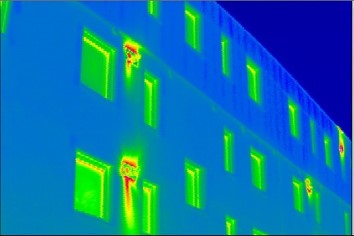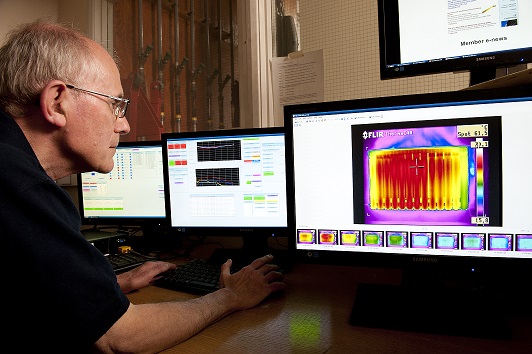Quantified assessment of thermal properties
The advantages of TIR inputs are mainly the very large amount of data obtained (each pixel of each image corresponds to one measurement), and the very reasonable cost of the measurement (the market offer related to TIR cameras has recently evolved consequently towards lighter and cheaper devices). However, for the moment, in the construction sector, most of the measurements carried out from TIR devices are exploited in a mostly qualitative way (observation of thermal bridges).
In Built2Spect project we will propose methods to allow quantified assessment of thermal properties of buildings thanks to TIR devices. These methods rely on Augmented Reality to acquire data directly in the model and indirect and direct thermal modeling to analyze it. Several steps in terms of scientific and technical developments are needed for such technological progress.
I have been testing the FlirONE thermal imaging camera with my iPhone and it has been a very interesting and very enlightening tool. The ability to see hot spots in equipment and to see aspects of the thermal performance of a building on a hand held, pocket device is fantastic. I like the lightweight and easy to use body of the Flir ONE the most.” JoeMazzon (Research Engineer, BSRIA Ltd.)
- Methods to allow quantified assessment of thermal properties
- Augmented reality
- Indirect and direct thermal modelling
 Thermal Imaging © Passive House Institute
Thermal Imaging © Passive House Institute
 Analysing results of thermal imaging © BSRIA
Analysing results of thermal imaging © BSRIA
Reports
State of the art: next generation thermal self-inspection technique
In this report the project partners ENSAN and University of Bordeaux summarise and compare methodologies to measure thermal properties of solids and analyse and explore diagnostic methods for thermal parameters of buildings in situ. On this basis, they propose a precise, fast and cheaper method which might be helpful in the future.
Building modelling and 3D automated referencing
Built2Spec aims at developing an integrated solution for a non-intrusive evaluation of the local thermal performance values of a wall (U-values, thermal storage capacity) from external remote sensing measurements, combining TIR measurements (from already existing technology) with new quantitative analysis methods. This kind of development is still used in the research lab only. The first part of this report below is dedicated to Building Modelling and the second part to 3D referencing.